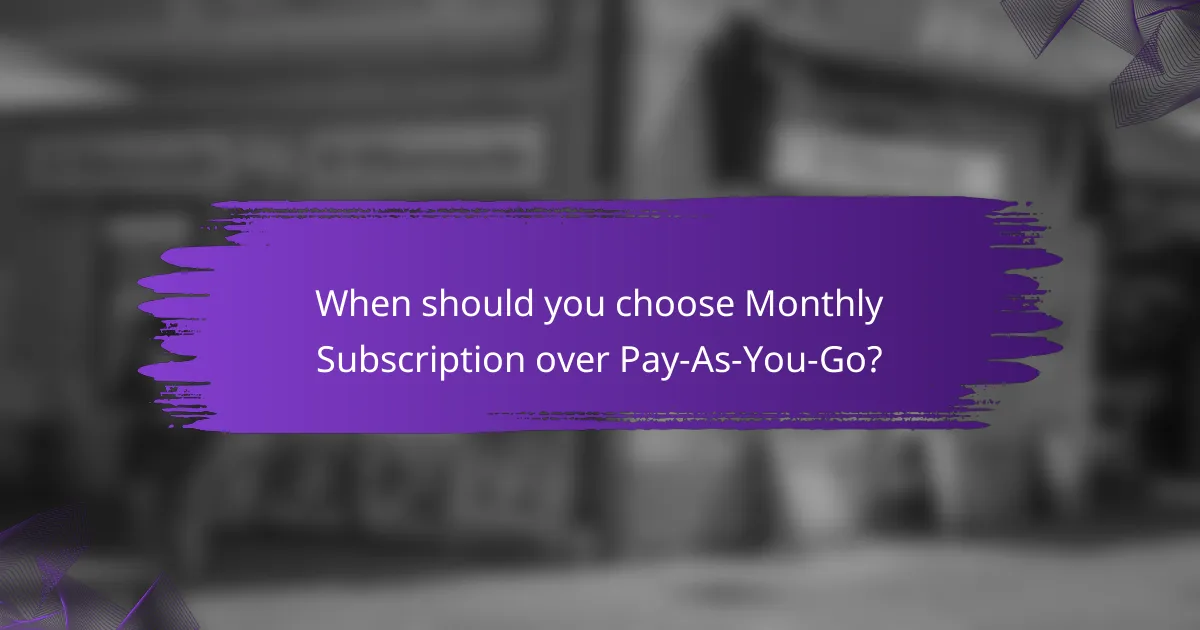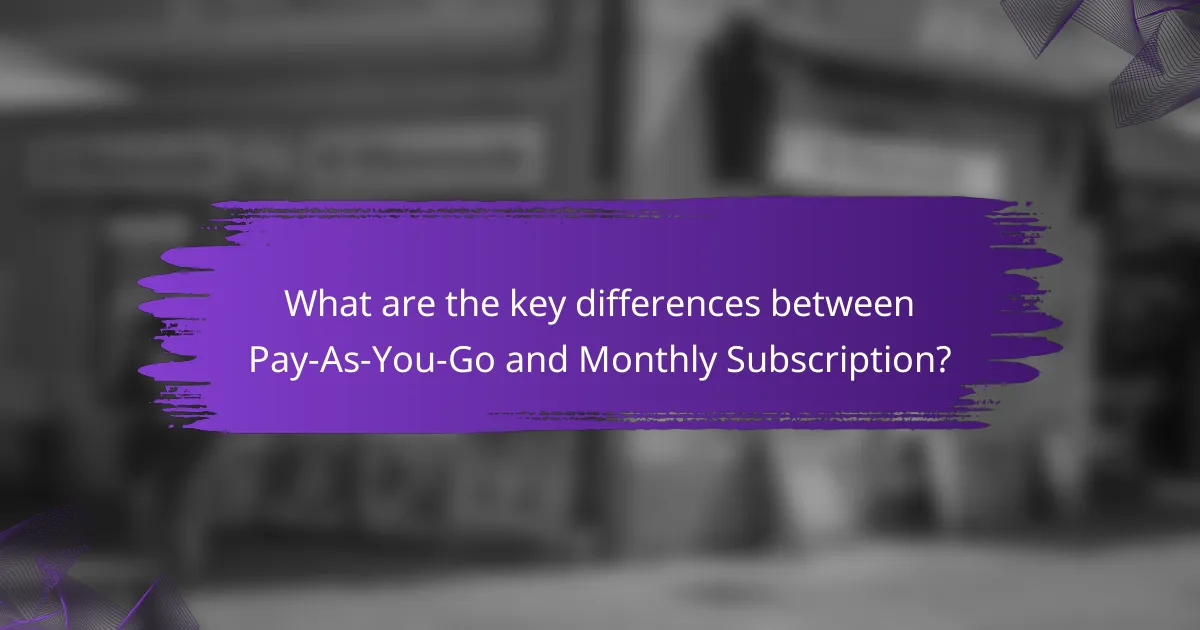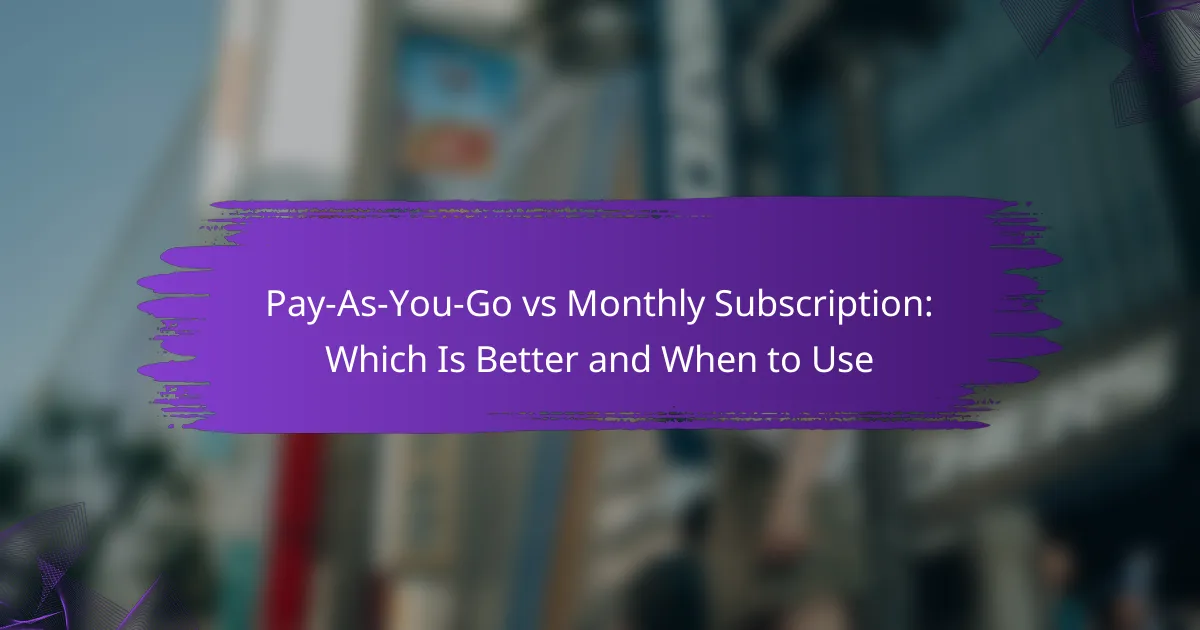When choosing between Pay-As-You-Go and monthly subscription plans, it’s essential to consider your usage patterns and financial preferences. Pay-As-You-Go offers flexibility and cost control, making it suitable for those with fluctuating needs, while monthly subscriptions provide consistent access and easier budgeting for regular users. Understanding the strengths of each option can help you make an informed decision that best suits your lifestyle.

What are the benefits of Pay-As-You-Go plans in the UK?
Pay-As-You-Go plans in the UK offer users the ability to pay only for the services they actually use, making them an attractive option for those who prefer flexibility and cost control. These plans are particularly beneficial for individuals with varying needs or those who do not want to commit to a monthly subscription.
Flexibility for occasional users
Pay-As-You-Go plans are ideal for occasional users who may not require regular access to a service. This model allows users to activate and deactivate services as needed, avoiding unnecessary charges during periods of low usage. For example, someone who only travels occasionally can activate a mobile data plan only when needed.
This flexibility ensures that users can tailor their spending to their actual usage patterns, making it easier to manage budgets without being locked into a fixed monthly fee.
No long-term commitment
One of the key advantages of Pay-As-You-Go plans is the absence of long-term commitments. Users can choose to use a service without the pressure of a contract, allowing them to switch providers or services without penalties. This is particularly beneficial in the UK, where many providers offer competitive rates that can change frequently.
This lack of commitment empowers users to make decisions based on current needs and market offerings, ensuring they are not tied to a service that no longer meets their requirements.
Cost-effective for low usage
For individuals or businesses with low usage, Pay-As-You-Go plans can be significantly more cost-effective than monthly subscriptions. Users only pay for what they consume, which can lead to savings, especially if their usage fluctuates. For instance, a user who only requires a few gigabytes of data each month will benefit from paying per use rather than a flat monthly fee.
Additionally, this model can help avoid overage charges that might occur with a subscription plan if usage exceeds the allotted amount. Users should regularly assess their usage patterns to determine if a Pay-As-You-Go plan remains the most economical choice for their needs.

What are the benefits of Monthly Subscription plans in the UK?
Monthly subscription plans in the UK offer users consistent access to services at a fixed cost, making budgeting easier. These plans are particularly advantageous for those who use a service regularly, as they often come with additional perks and features.
Predictable monthly costs
One of the main benefits of monthly subscription plans is the predictable monthly costs they provide. Users can plan their budgets without worrying about fluctuating fees, as the subscription amount remains constant each month.
This stability is especially beneficial for services like streaming platforms or software tools, where users can expect to pay the same amount regardless of usage. For example, a subscription might cost around £10 to £15 per month, allowing for straightforward financial planning.
Access to premium features
Monthly subscriptions often grant users access to premium features that are not available with pay-as-you-go options. This can include exclusive content, advanced functionalities, or enhanced customer support.
For instance, a music streaming service may offer higher audio quality and offline listening capabilities to subscribers, making the monthly fee worthwhile for avid listeners. These premium features can significantly enhance the user experience.
Better value for frequent users
For those who use a service frequently, monthly subscriptions typically provide better value compared to pay-as-you-go models. Regular users can save money in the long run, as the cumulative costs of individual transactions can quickly exceed the monthly fee.
For example, if a user streams movies multiple times a week, a subscription costing £12.99 per month is likely more economical than paying £3.99 per rental. Evaluating usage patterns can help determine if a subscription is the most cost-effective choice.

When should you choose Pay-As-You-Go over Monthly Subscription?
Pay-As-You-Go is ideal when you need flexibility and want to avoid long-term commitments. This model allows you to pay only for what you use, making it suitable for varying usage patterns and budget considerations.
Infrequent usage scenarios
If you only need a service occasionally, Pay-As-You-Go can save you money compared to a monthly subscription. For example, if you use a cloud storage service just a few times a year, paying per use is more economical than committing to a monthly fee.
Consider services like ride-sharing or streaming platforms that charge based on usage. If you only use these services sporadically, the pay-as-you-go model allows you to access them without incurring unnecessary costs.
Budget constraints
For individuals or businesses with tight budgets, Pay-As-You-Go offers a way to manage expenses effectively. This model allows you to control spending by only paying for services when needed, avoiding the fixed costs associated with monthly subscriptions.
For instance, freelancers or small businesses can benefit from this model by using software tools only when projects demand them, thus aligning costs with income and preventing cash flow issues.
Testing new services
When exploring new services, Pay-As-You-Go allows you to test without a long-term commitment. This is particularly useful for software or platforms that may not meet your needs after initial use.
By opting for a pay-as-you-go plan, you can evaluate the service’s effectiveness and features without the pressure of a monthly subscription. If the service proves valuable, you can then consider switching to a subscription model later on.

When should you choose Monthly Subscription over Pay-As-You-Go?
Choosing a monthly subscription is ideal when you have consistent usage needs and want to save money over time. Subscriptions often provide better value for regular users, offering access to features or content that pay-as-you-go options may lack.
Regular usage patterns
If you frequently use a service, a monthly subscription is likely more cost-effective. For example, streaming platforms typically charge a flat fee for unlimited access, while pay-as-you-go options can quickly add up if you watch multiple shows or movies each month.
Consider your usage habits. If you find yourself using a service multiple times a week, a subscription can simplify budgeting and ensure uninterrupted access.
Long-term savings
Monthly subscriptions often lead to significant long-term savings compared to pay-as-you-go models. For instance, a subscription might cost around $10 to $15 per month, while occasional use could rack up costs that exceed $30 or more in the same timeframe.
Evaluate how much you typically spend on a service over several months. If the subscription fee is lower than your average pay-as-you-go expenses, it’s a smart financial choice.
Access to exclusive content
Many subscription services offer exclusive content or features not available through pay-as-you-go options. This can include early access to new releases, premium features, or special discounts.
For example, gaming platforms often provide subscribers with free games or in-game content that pay-as-you-go users cannot access. If exclusive content is important to you, a subscription may be the better option.

What are the key differences between Pay-As-You-Go and Monthly Subscription?
Pay-As-You-Go and Monthly Subscription models differ primarily in their payment structures and commitment levels. Pay-As-You-Go allows users to pay only for what they use, while Monthly Subscriptions require a fixed payment for access over a set period, regardless of usage.
Payment structure
In a Pay-As-You-Go model, users are billed based on actual usage, which can vary significantly from month to month. This structure is beneficial for those with fluctuating needs, as it prevents overpayment for unused services.
Conversely, a Monthly Subscription involves a consistent fee, which can simplify budgeting and provide predictable costs. This model is ideal for users who require regular access to services or products, ensuring they can use them without worrying about additional charges.
Usage commitment
Pay-As-You-Go typically requires no long-term commitment, allowing users to stop using the service without penalties. This flexibility is advantageous for those who may only need the service intermittently or want to try it out before making a longer-term commitment.
On the other hand, Monthly Subscriptions often come with a commitment for the duration of the billing cycle. Users may face cancellation fees or lose access to services immediately upon cancellation, which can be a drawback for those uncertain about their long-term needs.
Cost implications
With Pay-As-You-Go, costs can be unpredictable, especially if usage spikes unexpectedly. However, this model can lead to savings for occasional users who would otherwise pay for unused services in a subscription.
Monthly Subscriptions generally offer lower per-use costs if usage is consistent, making them cost-effective for regular users. It’s important to assess your usage patterns to determine which model aligns better with your financial situation and service needs.
